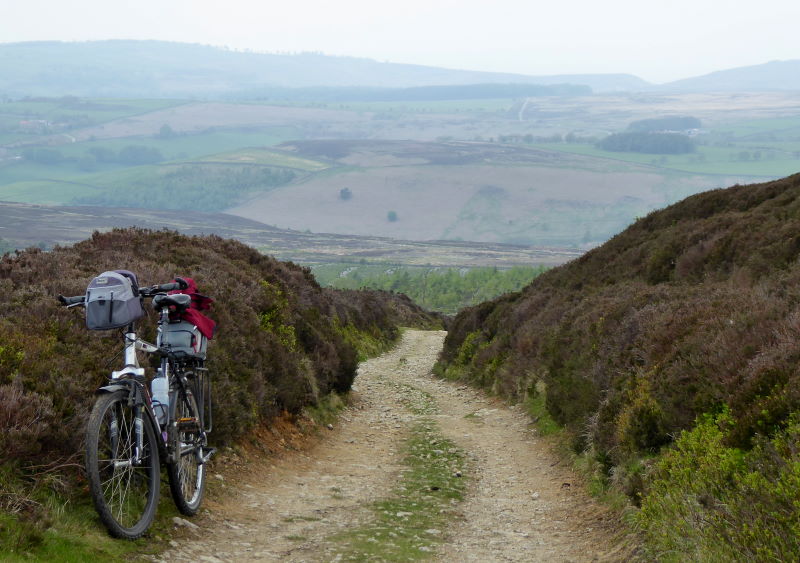Before the railways, drove roads were how livestock got from farm to market. Drovers followed well-drained ridgeways, avoiding both bogs and costly turnpikes down below; they were used to handling stubborn, lumbering beasts.
All of which also applied to me today, with my trekking bike as the beast in question, and the route being Hambleton Drove Road: one of England’s finest surviving examples of the genre.
Hambleton Road used to transport cattle, sheep and geese between Durham and York, and the best and most cyclable section is the ten miles between Sutton Bank and Osmotherley. Which is what I was riding today.

It was a trip back in time, to the days when life was largely spent at home, visiting even the next town was only done for essential purposes, and foreign travel was a wild fantasy. May 2020, for instance.

I took the train to Thirsk, judiciously stocking up on snacks at Lidl, and after some glorious morning scenery I climbed up to Sutton Bank via a road I’d not cycled before, Sneck Yate Bank. In the list of top 100 climbs this ranks 437th, apparently, but it feels tougher. I was glad to see I wasn’t the only one pushing the final stretch of 25%.

From here, Hambleton Drove Road runs mostly straight and level along the edge of the uplands, always scenic, sometimes awesomely so. To the left, green hillsides and valleys tumble down to the plains below. To the right, the vast purple flats of the moortops, thick with heather. If you dropped your phone here you’d stand no chance whatever of finding it again.

It’s a terrific ride, and the surface is pretty good, mud-free and dry, almost all the way. Former mudbaths through Boltby Forest, or north of Black Hambleton, or down to the ford at Cod Beck, are now pleasant gravel.
The only tricky bit is 100m or so of rough, rocky steepness on the side of Black Hambleton. I pushed down this; a determined bloke on a mountain bike rode up it as I did so, wheezing and steaming like Ivor the Engine.

On a full-sus MTB it’d feel as smooth as, say, hot chocolate. On my trekker – a hardtail MTB adapted for light touring with raised handlebars and sporting barbag and rackpack – it was fine, like, say, an Americano with milk. On a gravel bike it’d be, maybe, a cappuccino from a carelessly cleaned machine: exhilarating but abrasive. And on a road bike, perhaps, a stewed filter coffee like you get in American hotel lobbies: bitter, unpleasant and best avoided.

It was fine weather, and the ride was bliss. I kept overtaking joggers and strolling families and horse riders, only for them to pass me when I stopped to take pictures, before repeating the process several times.

One couple were ministering to their dog, who had a stick stuck in its fur in a painful place; my Swiss Army Knife came in handy, and they did some discreet snipping before going gratefully on their way. It was a bit of a novelty: my knife is generally used only for opening things.

The views just kept coming. Eventually I crunched down the final descent to Cod Beck, east of Osmotherley, and picnicked by the reservoir along with lots of day-tripping families. Its water isn’t fit to drink any more – cryptosporidium, apparently – so its only role is in flow management, and to provide a pleasant place to eat your Lidl Snack Pork Pies and Pecan Plait.

Osmotherley is a fine example of a North York Moors village. There’s a market cross and historic stone table, where transactions were laid out and no doubt drovers might do a deal or two en route to York or Durham.

Around it are three pubs, where a few other transactions were doubtless regularly made too. Mindful of the need to support local hospitality business in the current situation, that’s what I did, before trundling back west to Northallerton for my train home.
It had been a beautiful, beautiful day’s ride.
MAP

